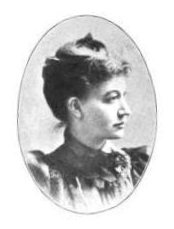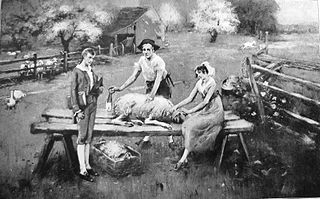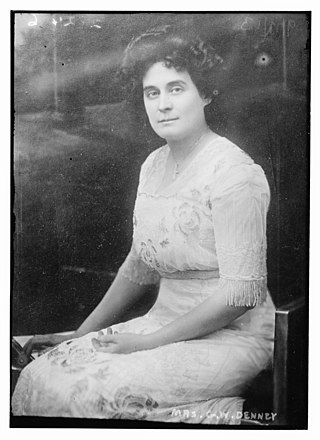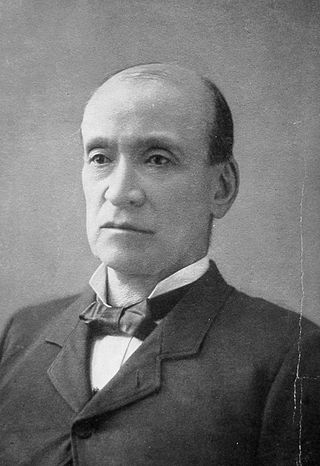
Powell, formerly known as Powell Station, is a census-designated place in Knox County, Tennessee. The area is located in the Emory Road corridor, just north of Knoxville, southeast of Clinton, and east of Oak Ridge. It had a population of 13,802 during the 2020 census. It is included in the Knoxville, TN Metropolitan Statistical Area.
Concord is an unincorporated community in Knox County, Tennessee, United States and is listed on the National Register of Historic Places as a historic district, the Concord Village Historic District. The United States Geographic Names Information System classifies Concord as a populated place. It is located in western Knox County, east of Farragut and west of Knoxville. Mail destined for Concord is now addressed to Concord, Knoxville, or Farragut.
John Hervey Crozier was an American attorney and politician active primarily in Knoxville, Tennessee, USA, during the mid-nineteenth century. Described as "an orator of uncommon brilliancy" and "one of the brainiest men ever sent by Tennessee to congress," Crozier represented Tennessee's 3rd congressional district in the United States House of Representatives from 1845 to 1849. While originally a member of the Whig Party, Crozier switched his allegiance to the Democratic Party in the 1850s, and supported the Confederacy during the Civil War. Crozier retired from public life after the war, and spent his remaining years engaged in scholarly pursuits.

The Knoxville Gazette was the first newspaper published in the U.S. state of Tennessee and the third published west of the Appalachian Mountains. Established by George Roulstone (1767–1804) at the urging of Southwest Territory governor William Blount, the paper's first edition appeared on November 5, 1791. The Gazette provided an important medium through which Tennessee's frontier government could dispense legislative announcements, and the paper's surviving editions are now an invaluable source of information on life in early Knoxville.

Thomas Amos Rogers Nelson was an American attorney, politician, and judge, active primarily in East Tennessee during the mid-19th century. He represented Tennessee's 1st Congressional District in the 36th U.S. Congress (1859–1861), where he gained a reputation as a staunch pro-Union southerner. He was elected to a second term in 1861 on the eve of the Civil War, but was arrested by Confederate authorities before he could take his seat.

The East Tennessee, Virginia and Georgia Railroad (ETV&G) was a rail transport system that operated in the southeastern United States during the late 19th century. Created with the consolidation of the East Tennessee and Virginia Railroad and the East Tennessee and Georgia Railroad in 1869, the ETV&G played an important role in connecting East Tennessee and other isolated parts of Southern Appalachia with the rest of the country, and helped make Knoxville one of the region's major wholesaling centers. In 1894, the ETV&G merged with the Richmond and Danville Railroad to form the Southern Railway.

The Ramsey House is a two-story stone house in Knox County, Tennessee, United States. Also known as Swan Pond, the house was constructed in 1797 by English architect Thomas Hope for Colonel Francis Alexander Ramsey (1764–1820), whose family operated a plantation at the site until the U.S. Civil War. In 1969, the house was added to the National Register of Historic Places for its architecture and its role in the region's early 19th-century history.

Statesview, or States View, is a historic house located on South Peters Road off Kingston Pike in Knoxville, Tennessee, United States. Built in 1805 by Knoxville architect Thomas Hope and rebuilt in 1823 following a fire, Statesview was originally the home of surveyor Charles McClung. Following McClung's death, newspaper publisher Frederick Heiskell purchased the house and estate, which he renamed "Fruit Hill." The house is listed on the National Register of Historic Places for its architecture and political significance.

Old Gray Cemetery is the second-oldest cemetery in Knoxville, Tennessee, United States. Established in 1850, the 13.47-acre (5.45 ha) cemetery contains the graves of some of Knoxville's most influential citizens, ranging from politicians and soldiers, to artists and activists. The cemetery is also noted for the Victorian era marble sculpture and elaborate carvings adorning many of the grave markers and headstones. In 1996, the cemetery was added to the National Register of Historic Places.

The Knox County Courthouse is a historic building located at 300 Main Street in Knoxville, Tennessee, United States. Built in 1886, it served as Knox County's courthouse until the completion of the City-County Building in 1980, and continues to house offices for several county departments. John Sevier, Tennessee's first governor, is buried on the courthouse lawn. The courthouse is listed on the National Register of Historic Places for its architecture and its role in the county's political history.
The East Tennessee Historical Society (ETHS), headquartered in Knoxville, Tennessee, United States, is a non-profit organization dedicated to the study of East Tennessee history, the preservation of historically significant artifacts, and educating the citizens of Tennessee. The society operates a museum and museum shop in the East Tennessee History Center on Gay Street in downtown Knoxville. The East Tennessee Historical Society was established in 1834, 38 years after the establishment of the state of Tennessee, to record the history of the development and settlement of the area.

Margaret Elizabeth Crozier French was an American educator, women's suffragist and social reform activist. She was one of the primary leaders in the push for women's rights in Tennessee in the early 1900s, and helped the state become the 36th state to certify the 19th Amendment to the United States Constitution, giving women the right to vote, in 1920. She also founded the Ossoli Circle, the oldest federated women's club in the South, and led efforts to bring coeducation to the University of Tennessee.

James Gettys McGready Ramsey was an American historian, physician, planter, slave owner, and businessman, active primarily in East Tennessee during the nineteenth century. Ramsey is perhaps best known for his book, The Annals of Tennessee to the End of the Eighteenth Century, a seminal work documenting the state's frontier and early statehood periods. Ramsey was also a major advocate for development in East Tennessee, leading efforts to bring railroad access to the region, and helping to organize the region's first medical society.

Samuel Czar Carrick was an American Presbyterian minister who was the first president of Blount College, the educational institution to which the University of Tennessee traces its origin.

Jane Franklin Hommel Denney (1878–1946), clubwoman, was president of the Tennessee Federation of Women's Clubs, in Knoxville, Tennessee, US.

The East Tennessee Female Institute was an all-female institution of higher learning that operated in Knoxville, Tennessee, United States, from 1827 until 1911. Originally chartered as the Knoxville Female Academy, the school offered high school and college-level courses to the women of Knoxville and surrounding counties in the years before the University of Tennessee became coeducational. With the rise of free public education in Knoxville in the early 1900s, the institute, which was tuition-based, gradually declined.

Oliver Perry Temple was an American attorney, author, judge, and economic promoter active primarily in East Tennessee in the latter half of the 19th century. During the months leading up to the Civil War, Temple played a pivotal role in organizing East Tennessee's Unionists. In June 1861, he drafted the final resolutions of the pro-Union East Tennessee Convention, and spent much of the first half of the war providing legal defense for Unionists who had been charged with treason by Confederate authorities.
James Churchwell Luttrell II was an American attorney and politician who served as Mayor of Knoxville, Tennessee, during the Civil War. His eight-year term (1859–1867) was the longest for any Knoxville mayor until the late 20th century, when it was surpassed by Victor Ashe's 16-year term. Luttrell also served as state comptroller in the late 1850s, and was elected to the state senate following his term as mayor.

Mary Boyce Temple was an American philanthropist and socialite, active primarily in Knoxville, Tennessee, in the late 19th and early 20th centuries. She was the first president of the Ossoli Circle, the oldest federated women's club in the South, and published a biography of the club's namesake, Margaret Fuller Ossoli, in 1886. She also cofounded the Tennessee Woman's Press and Author's Club, the Knoxville Writer's Club, and the Knox County chapter of the League of Women Voters. She represented Tennessee at various international events, including the Paris Exposition of 1900 and at the dedication of the Panama Canal in 1903.

Mary Utopia Rothrock, was an American librarian and historian.


















